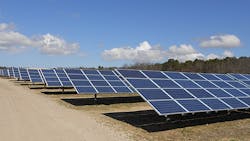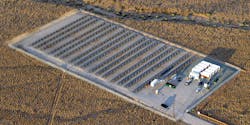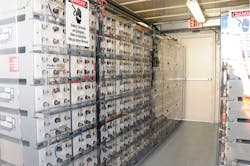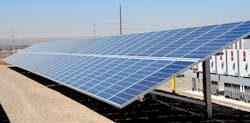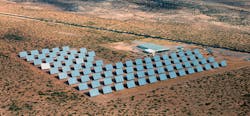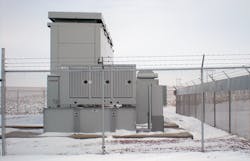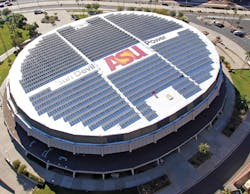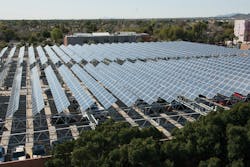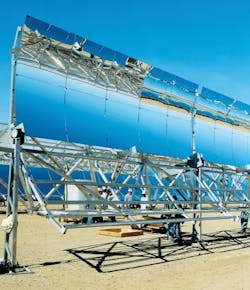The portion of electricity generated by renewable energy sources is climbing substantially each year all around the world. It is mostly because of an increase in solar photovoltaic (PV) systems brought about by dropping prices. Experts within the electric industry are not in agreement as to what should be done about this. Their opinions are diverse, to say the least, but they do agree that as wind and solar increase, so do the problems associated with operating this new grid.
The discussion is centered on the variability of wind and solar generation. These resources can be pumping their maximum capacity of electricity into the grid one minute and be completely gone the next. Because of their intermittency, these power sources are defined as nondispatchable. That simply means the maximum available power output from wind and solar varies over time and predictability is uncertain.
This variability costs utilities plenty of money when renewables are operating on the system. Utilities have to keep fossil fuel plants operating to take up the slack when the wind stops blowing or clouds pass over the solar array. When that happens, those base load power plants are operating at lower-capacity factors with much less efficiency.
The key to this problem is the liberal application of energy storage systems at the source of the problem. It can make these renewable resources behave like other dispatchable generation by addressing their variability. This is extremely important today because renewable generation has become such a significant source of electricity on the 21st century grid.
Megawatt, Gigawatt, Terawatt
What is a significant source? What exactly does that mean in installed generation capacity? The Renewable Energy Policy Network for the 21st Century’s (REN21’s) “Renewables 2013 Global Status” report stated, “Renewables made up a little over half of the total net additions to electric generating capacity from all sources by the end of 2012.” That is substantial, but REN21 went on to say that, by the end of 2012, renewables “comprised more than 26% of global generation.”
In 2013, more than 35,000 MW of wind generation was brought on-line worldwide according to the Global Wind Energy Council (GWEC). GWEC reports this addition took the total global wind capacity to 318,105 MW. On the solar side, the European Photovoltaic Industry Association (EPIA) reported the global installation of PV solar arrays increased by 37,000 MW in 2013. The combined 2013 GWEC and EPIA figures show wind and PV increased by more than 72,000 MW in one year. Early reports for 2014 show a continued upward-bound growth pattern.
Can Regulations Help?
With growth like this, the need for dispatchable wind and solar is becoming more critical than ever before. The strange thing about making renewables dispatchable is the fact it is not really a question of developing some new technology, it is a question of economics. Energy storage technology has been available for years, but there has been a lot of resistance to installing it. The cost and who is responsible for that cost has been a major stumbling block to wholesale deployment of the technology.
In an effort to push the storage issue forward, California’s Public Utility Commission (PUC) passed an energy storage mandate last year. The mandate requires California utilities to procure and install more than 1,300 MW of energy storage capacity by 2020. The California PUC sees this mandate addressing two important issues: it will get the storage out on the grid where it is needed, and the storage will make the network stronger and more reliable by tackling the intermittency issues of wind and solar.
Texas, New York, Hawaii and Washington also have proposed significant storage policies, and they are watching developments in California. On the national level, two bills are pending in Congress (H.R. 1465 and S. 1030) to establish incentives for storage deployment. In addition, the Federal Energy Regulatory Commission (FERC) put its weight behind the energy storage issue. FERC issued two orders that should help with energy storage systems. These orders (784 and 792) give energy storage technology the boost needed to improve their deployment on the grid.
Order 784 requires utilities to consider speed and precision when selecting ancillary services (note, ancillary services are defined as power sources a utility can buy on an as-needed basis). Order 792 effectively makes energy storage a power source eligible to connect to the grid. In effect, this puts storage in the same category as the existing small generator interconnection procedures, making it eligible for the fast-track process.
It is sufficient to say regulators and governing bodies are getting involved with energy storage for better or worse. Taking a positive outlook, regulatory support should help with the deployment of this technology.
Game Changer
Do not get the impression there is not storage on the grid; there certainly is and there is a lot of it, but not all energy storage is created equally. The International Energy Agency (IEA) estimated there was more than 145 GW of installed energy storage worldwide by the end of 2012. IEA projects an estimated 310 GW of additional grid-connected storage will be needed in the U.S., Europe, India and China by 2050 to keep up with energy demands.
Navigant Research reports that roughly US$150 million was spent worldwide on storage for renewables in 2013 and projects the amount could grow to $2.5 billion by 2023. The U.S. Department of Energy (DOE) has started an international energy storage database to keep track of this growing trend. It had listed more than 420 documented energy storage projects from 34 countries.
Before proceeding, it is important to look at the characteristics of the technology. Energy storage systems come in all sizes and shapes. Storage can supply electricity in ranges from milliwatts to megawatts that can be delivered in fractions of a cycle or over many hours — the choice is up to the buyer. With this variety of choices, it is important to select the right device based on the application. Those applications include energy management, backup power, load leveling, frequency regulation, voltage support and grid stabilization, to name a few.
Small, Medium, Large
Typically, large wind and solar farms require utility-scale bulk storage systems capable of supplying enormous amounts of power for many hours. The grid also has requirements for medium and small storage systems in addition to the large-scale systems. Medium, also known as intermediate, storage systems can be found in substations supporting distribution feeders and on industrial solar applications. Small storage systems are ideal for use in residential feeders and rooftop PV systems.
When looking at large-scale applications, there are batteries, pumped hydroelectric storage (PHS) and compressed air energy storage (CAES). PHS has been the leader for more than 100 years. IEA estimates that of the 145-GW storage it reported in service, 99% of it is PHS.
Unfortunately, PHS is limited by geography and does not lend itself to flat, arid topography, which describes so much of the topography in which wind and solar are found. CAES also has been available for many years, but, with only two commercial systems installed, it has not been embraced by the industry.
Like PHS, CAES has geographical limitations that have impacted its deployment. It needs some form of underground fissures or caverns for storage of the compressed air, which limits its deployment, but that could be changing. A company named SustainX has developed a different approach. SustainX uses a special compressor/generator to pressurize air and pump it into large steel pipes (similar to those used in natural gas pipelines) when electricity is plentiful. The process can be reversed when power is needed.
All of this equipment is housed in a building that can be erected wherever the customer would like it. A demonstration system rated at 1.65 MW recently went into service. Several other manufacturers (including Bright Energy, Foresight Renewable Solutions and LightSail) are working on adaptations of CAES technologies.
Making It Dispatchable
Recently, there was a new twist to the idea of pumping air for energy storage purposes. GE and Highview Power signed a collaboration agreement for a liquid air energy storage (LAES) system. It is not geographically constrained as PHS and CAES are, but LAES has many of the same advantages.
Highview Power has developed a process that uses off-peak electricity and a refrigeration system to cool air to -196ºC (-321ºF). This process reduces 700 liters (185 gal) of ambient air into a liter of liquefied air, which is stored in an insulated tank. When electricity is needed, the liquefied air is released, which turns it back into a gas as it expands in volume and drives a turbine creating the electricity. GE and Highview are investigating combining the LAES technology with peaker power plants using GE’s turbines and gas engines.
Battery energy storage systems (BESS) have been very successfully deployed in a number of cases. GE has introduced a variant of the sodium metal batteries offered by Japan’s NGK and Italy’s Fiamm. GE’s sodium Durathon BESS will be built in Niskayuna, New York, U.S. The Durathon BESS output is scalable for power and duration as needed by the system to which it is applied. The Durathon system has even been combined with GE’s popular wind turbine systems, giving the turbine the ability to store its own excess power.
ABB and Saft Groupe, SA have developed several interesting BESS devices. One device that combines ABB’s power electronics with Saft’s nickel-cadmium batteries was used in a system in Fairbanks, Alaska, U.S. Another collaboration featured ABB’s SVC Light technology with Saft’s lithium-ion battery to control voltage, active power flow and dynamic energy storage, known as the DynaPeaQ system.
Scalability
Next it is important to look at some different scales of energy storage systems. Medium and small systems are designed from a wide array of technologies such as batteries, flywheels, thermal storage and superconducting magnetic energy storage. Each technology has different performance characteristics, but batteries appear to be the most viable of the technologies. The others have been deployed as pilot projects with varying degrees of success, but they need more exposure to the industry.
New generations of advanced batteries have become available, thanks to improvements in electrochemistry, and they are attracting a great deal of attention. The more popular technologies include lithium-ion, sodium-metal halide, sodium sulfur, advanced lead acid and several flow batteries. The leader in utility-scale applications is the lithium-ion technology.
Manufacturers have developed what they call energy storage modules that come in arc-proof enclosures ranging from a few kilowatts to several megawatts at voltage levels from 120 V to 40 kV. These modules are being used in distribution energy storage (DES) systems and community energy storage (CES) systems.
S&C Electric has developed an interesting application using lithium-ion batteries and smart grid technology. S&C Electric’s PureWave CES system uses lithium-ion batteries installed on the feeders in close proximity of the customer. The CES systems are small padmounted devices (25 kW for one or two hours) installed strategically along residential feeders.
Smart Approach
For a total system approach, S&C Electric also can combine the CES with two-way communications and voltage sensors on the feeders along with intelligent controls for capacitors, load-tap changers and voltage regulators, making them a static VAR system. This is a powerful tool for dealing with large concentrations of rooftop PV, which are finding their way to feeders in many utility distribution networks.
Siemens provides a totally integrated DES system called SIESTORAGE. It is a modular energy storage and power flow management system that combines fast-acting power regulation and lithium-ion batteries. Distributed generation has caused fluctuations and imbalances between the generation and load. Being modular, the SIESTORAGE system can be brought to the point of the problem and address it.
Alstom has developed a stratagem known as a Network Energy Manager (NEM) system, which is a control system with energy storage. NEM coordinates renewable generation output, identifies grid constraints, schedules demand response and balances the input/output of the energy storage connected to the system. Alstom executives call NEM the “brain behind the grid.” It is being used on the grid in Nice, France.
Dispatchability is the ultimate goal of energy storage systems, but a total energy management system is becoming more desirable to utilities. It is another tool in the toolbox. ABB is moving utilities toward that goal with its PowerStore device, which has been called a grid stabilizer. It acts much like a static synchronous compensator (STATCOM) and combines advanced inverters with flywheels and smart software.
The flywheel can charge and discharge very rapidly at high duty cycles without experiencing performance degradation. The high-speed software controls the power into and out of the flywheel, making it a high inertia electrical shock absorber. This smooths any power fluctuations generated by the solar arrays. It can be combined with battery storage systems for a total system approach and, as an added bonus, the flywheels lessen the stress on the batteries.
Dispatchability
A tremendous effort is taking place worldwide to increase the amount of wind and solar generation interconnected to the grid, and it is very successful. Today’s power system has more renewable generation than ever before. With all the financial enticements, regulatory motivations and environmental inducements, tomorrow’s grid will only integrate more of it.
As the 21st century power system builds out, it is going to include a lot more wind and solar generation than it does today. To make it all work, there are big changes taking place on the grid and the application of energy storage systems is one of those. They are going to play a critical role in the successful integration of renewable energy resources into the grid.
Years ago, Charlie Smith, executive director of the Utility Variable-Generation Integration Group, summed it up in a past discussion by saying, “The Stone Age didn’t end because we ran out of stones.” The industry must move out of the Stone Age and take advantage of energy storage technology.
About the Author
Gene Wolf
Technical Editor
Gene Wolf has been designing and building substations and other high technology facilities for over 32 years. He received his BSEE from Wichita State University. He received his MSEE from New Mexico State University. He is a registered professional engineer in the states of California and New Mexico. He started his career as a substation engineer for Kansas Gas and Electric, retired as the Principal Engineer of Stations for Public Service Company of New Mexico recently, and founded Lone Wolf Engineering, LLC an engineering consulting company.
Gene is widely recognized as a technical leader in the electric power industry. Gene is a fellow of the IEEE. He is the former Chairman of the IEEE PES T&D Committee. He has held the position of the Chairman of the HVDC & FACTS Subcommittee and membership in many T&D working groups. Gene is also active in renewable energy. He sponsored the formation of the “Integration of Renewable Energy into the Transmission & Distribution Grids” subcommittee and the “Intelligent Grid Transmission and Distribution” subcommittee within the Transmission and Distribution committee.
